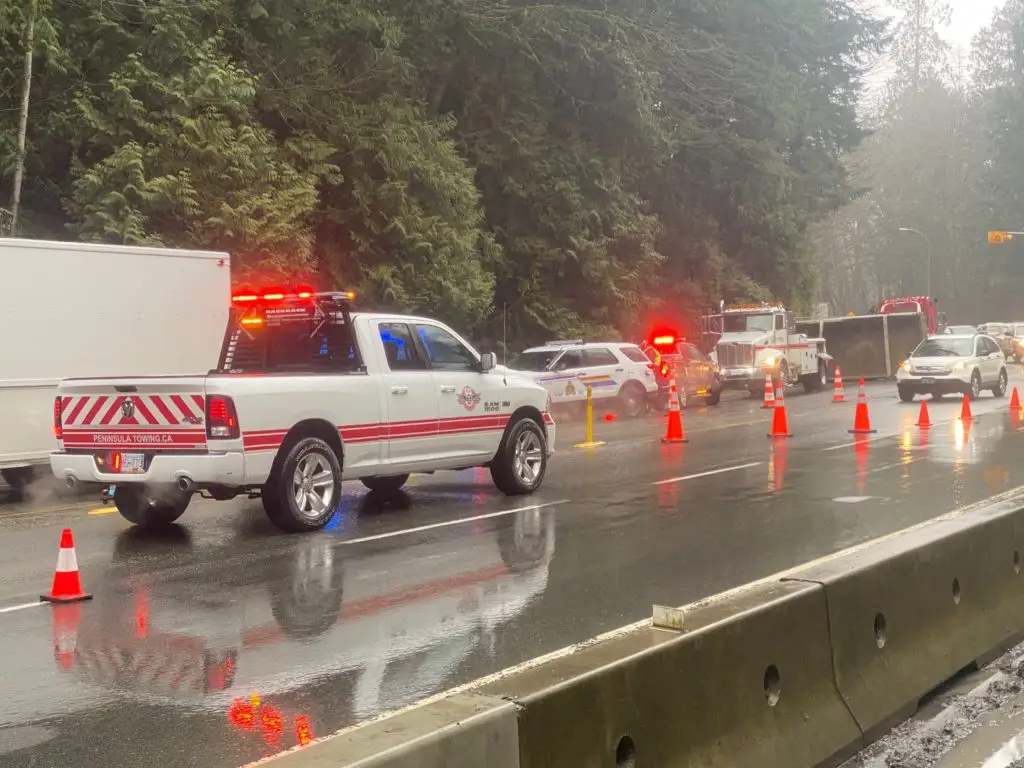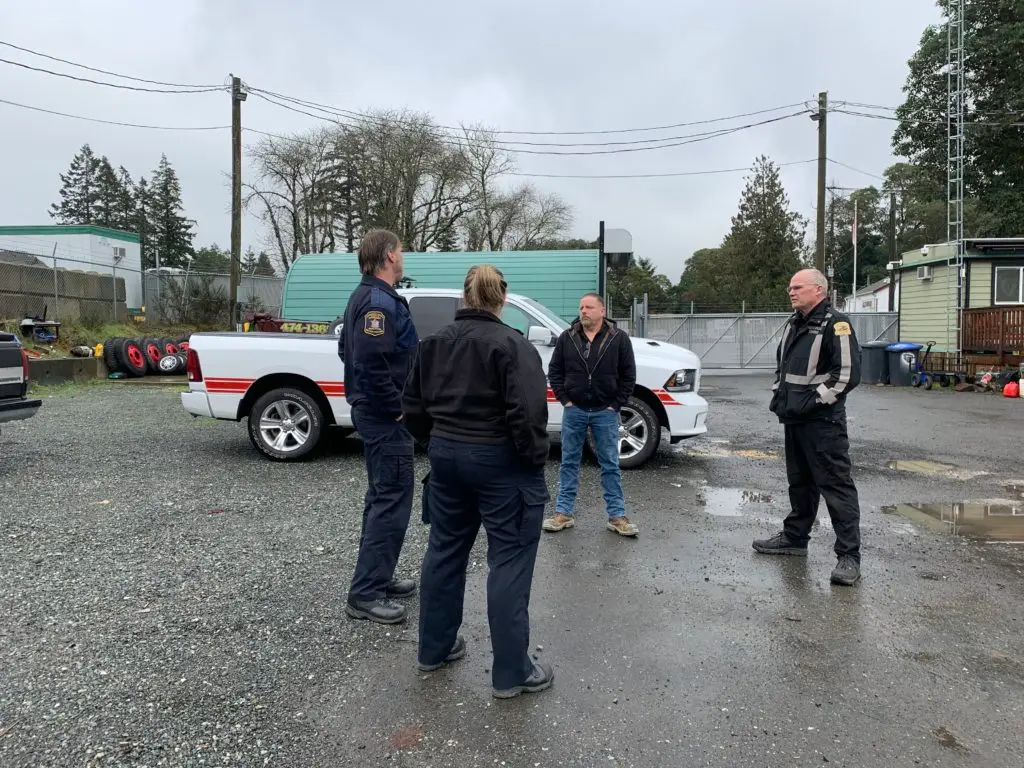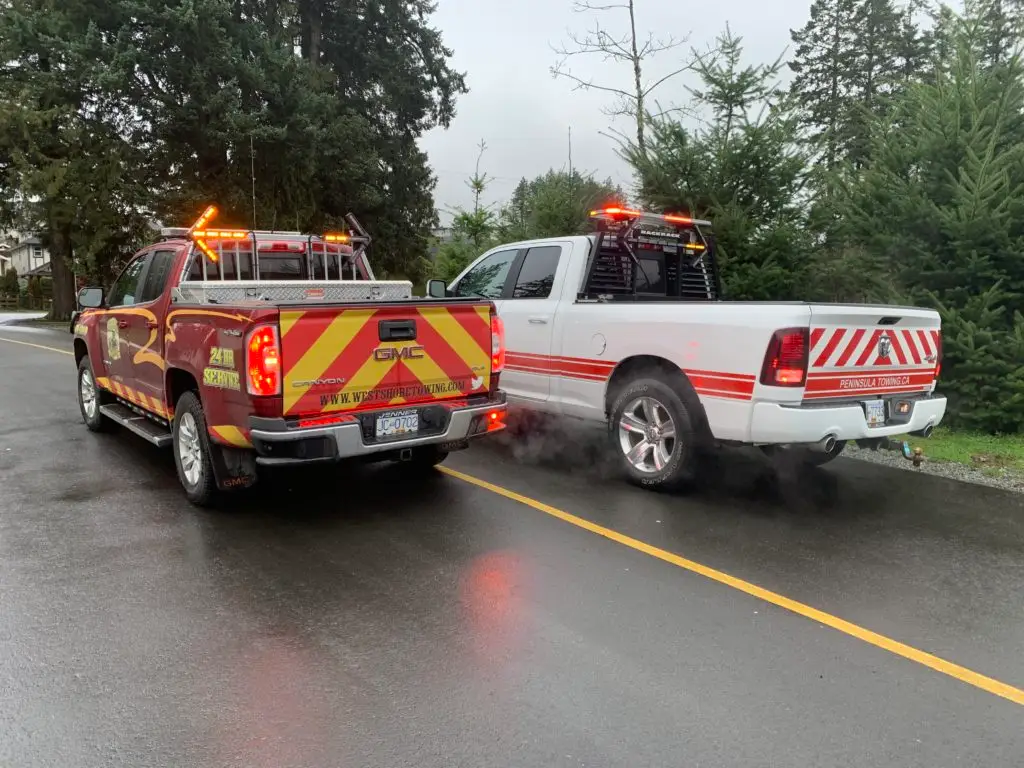While awaiting the approval of red lights, one operator has taken matters into his own hands and built a blocker truck to keep his team safe.
by Sarah Bruce
To block or not to block traffic is a debate many tow operators have with law enforcers in the fight to stay safe while working along the roadside. For Don Affleck, owner of Peninsula Towing on Vancouver Island, B.C.—who believes it is easier to ask for forgiveness than permission—the answer is straightforward: you have to do what you have to do to keep your operators safe.
“Five years ago, my youngest daughter had just been born and I was at the hospital when my son calls me and says, ‘Jeez I just about got hit on the highway,’” Don said. “He had cones out and was loading a generator that had blown a tire off when a car came through his cone zone and right up to him while he was running the controls.”
Thankfully, Don’s son was able to react in time to get out of the way, but he slapped the windshield of the car as it passed. Due to a previous rock chip, the force of impact was enough to crack the windshield, Don explained. “So the cones are all jammed up underneath the car and the police end up showing up, but what incensed my son so badly was that the officer was more focused on the broken windshield than the fact that the car had nearly hit my son by going through a cone zone.
There are two types of people: problem sufferers and problem solvers, and you have to ask yourself which one you are.”
“That upset me so badly,” Don said. “At a point when I should be excited about my daughter being born, I’m now upset that I almost lost my son on the highway, and then the police officers wouldn’t back us up.” It was then that Don realized it was up to him to make a difference.

“Years ago, I was at a BCAA convention and they said, ‘there are two types of people: problem sufferers and problem solvers, and you have to ask yourself which one you are.’ Right then and there it clicked and stuck with me,” Don said. “I’m a problem solver.”
So, following the incident, Don went out and bought the back end of an old blocker truck for $1,000. With its big red and orange chevrons on the back and rear-facing red lights, it stood out like a “baboon’s ass,” to use Don’s words to describe his first blocker truck. In fact, the truck stood out so well that the standing joke was that even though he wanted it to get hit—so he could get a new, nicer-looking truck—drivers just wouldn’t run into it!
Inspired by the blocker truck’s success, Don eventually invested in a beautiful brand- new Dodge, which he outfitted in company colours with reflective decals, lights, and a directional arrow used to warn traffic to slow down and move over for the accident scene ahead.
The blocker truck has helped his company by not only improving the safety of the tow operator working ahead at the scene but also with garnering more respect for the industry. “If we have a tow truck sitting out there, there’s always people complaining we are holding them up, honking, or screaming out the window at you, but I set this thing up, and nothing, no one’s yelling out the window because it looks like an official vehicle.
“We are getting the community used to it and it’s awesome,” Don said, explaining how his blocker truck has become so recognizable in his community that there’s no way he can hide when he drives around. Locals frequently comment things like, “‘You can’t miss it,’ ‘I see you a block ahead of me,’ and ‘I see you all over town.’” By driving the blocker truck around town, not only does it gain exposure for his company, it also raises awareness for tow operator safety. Don recalled one such story about a time when, after dropping his daughter off at school. While still in the parking lot, he witnessed a dad and his young son checking out the truck. The boy asked his dad if it was a fire truck—an easy mistake to make since the truck looks like something a fire official might drive—to which the dad replied, “This is the truck that goes out when that great big red tow truck goes out and blocks the traffic so they can safely work.” Don did not even know the man, but it seemed word about what the blocker truck signified was getting out.
Of course, every tow operator knows that maintaining a company with a fleet of trucks is not cheap and affording a truck used solely for blocking purposes is not always financially possible. However, blocker trucks “improve customer service from the minute we arrive, lights are going, directional going, I jump out, flip my tail gate down, throw out my five delineators, then I grab my cones and start walking along dropping those, and it’s just like that, instant safety,” Don said, and how do you put a price on that?
“There is economic opportunity here if everyone decides to latch on to it,” Don said. “When deck trucks first came out people were like, ‘I don’t know, what are going to do with a deck truck?’ Well, put your stuff on it and use it and then you can charge for it, just like any other business.
“We tell our customers we have to bill for a blocker, we need traffic control for this right now and they’re like, ‘oh yeah we understand.’ We have not once had anyone complain about it.” By being able to justify the charge, Don is able to keep his tow operators and customers safe. “We are making ourselves safe, the customer safe, the situation safe, and everybody that’s going to pass us safe.”

The next step is to gain approval for the rear-facing red lights he has installed on the back of the blocker truck. The Automotive Retailers Association’s (ARA) towing and recovery division is currently working with the B.C. government to allow tow trucks to be equipped with 360-degree flashing red lights. While this is in the works, Don, alongside Dave LeQuesne from Westshore Towing, who has also introduced a blocker truck into his fleet, are campaigning to Commercial Vehicle Safety and Enforcement (CVSE), WorkSafeBC, and the provincial government to allow rear-facing red lights. Rear-facing red lights fall into a sort of grey area of legislation considering some vehicles are already equipped with flashing red hazard lights.
“You get more action in a room with fewer voices because you can hear them and you won’t just have someone standing at the back bitching and complaining,” Don said, explaining how they’re going about asking for change. “Everyone wants to be part of the solution. We want to work with government.”
Dave says it should just be common sense. “Are there people exposed to active traffic while working alongside their vehicle? If yes, then they should be given every appropriate measure possible to keep them safe.” But he’s optimistic that they’ll be heard and that change is coming. “It’s like rolling a big rock, it doesn’t appear like it’s moving, but it is.”
